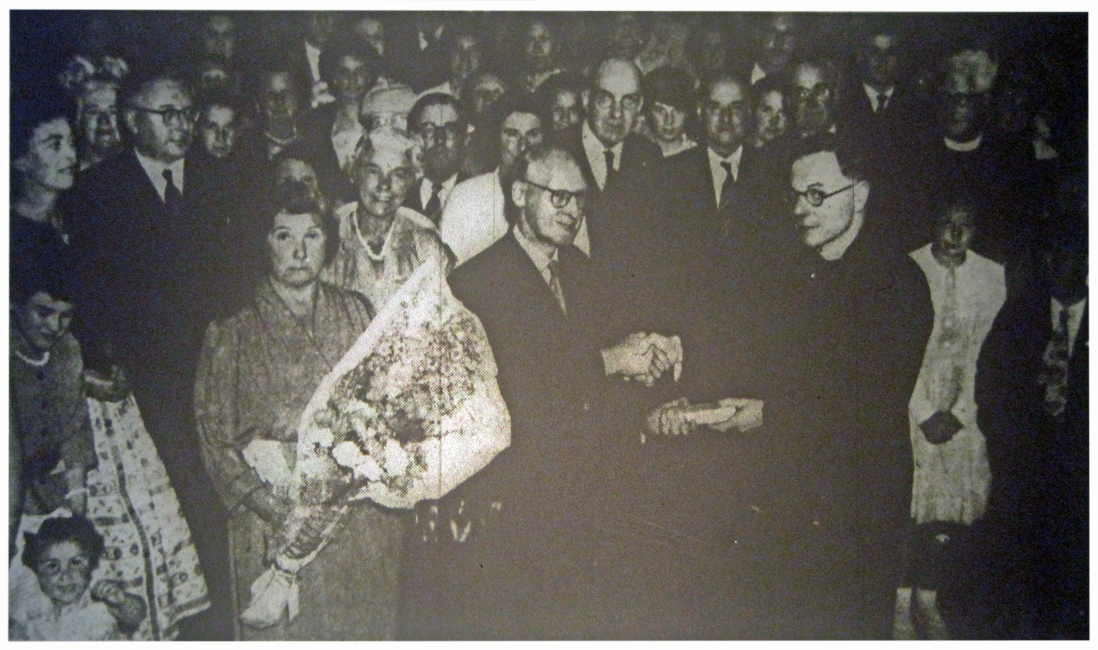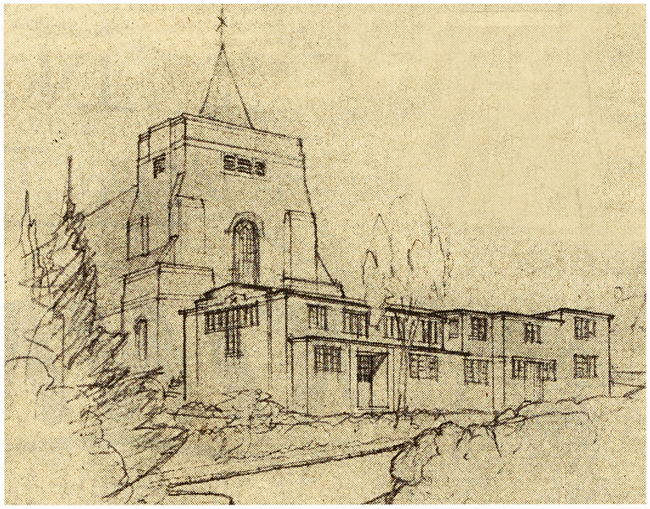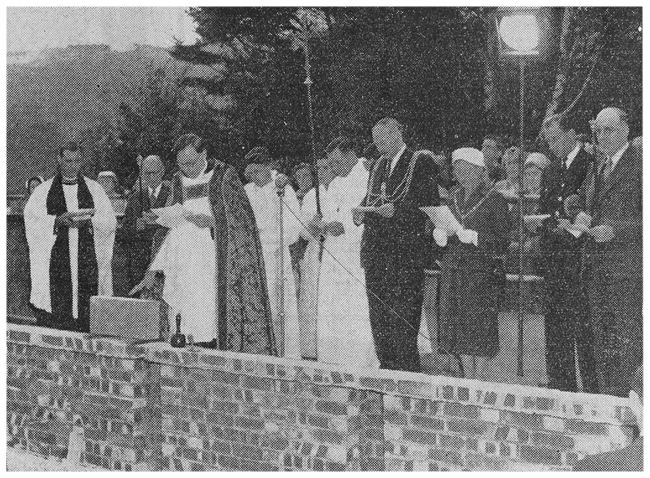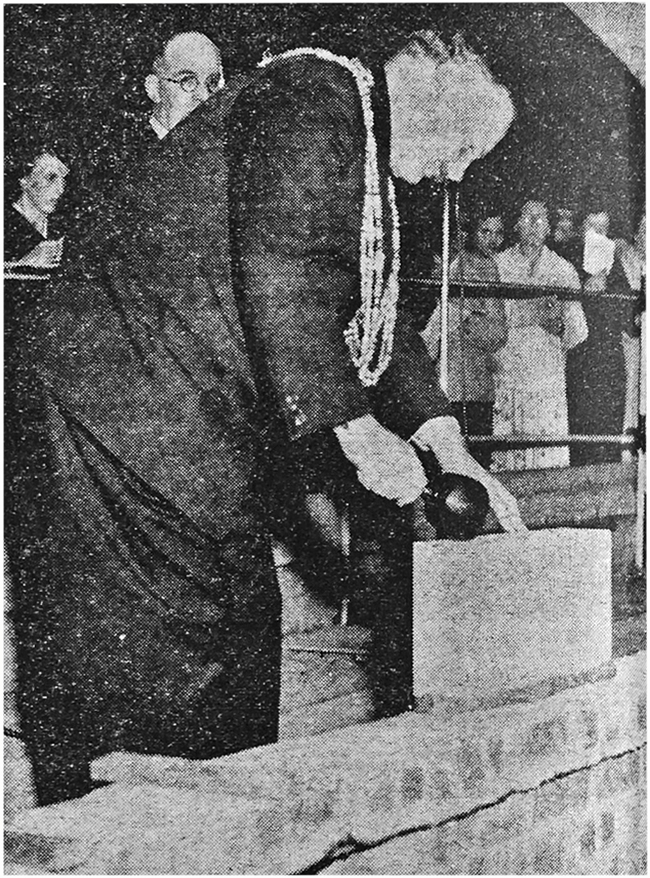
Churches - Bevendean History Project

Newspaper Articles for St Andrews Church 1957


The vicar of St. Andrew’s Church, Moulsecombe, the Rev. W. R. Newton, making presentations to Mr R. H. Bean on Thursday, to mark his 21 years as churchwarden. With Mr Bean is Mrs Bean, holding the bouquet presented to her by her three-year-old grandchild Anita Aldridge, seen in the left-hand bottom corner of the picture. Also in the group are the Rev. Bransby Jones, former vicar, now of Bosham (right), Mr and Mrs C. J. Whitten (left of the picture), Mr F. G. Carter (churchwarden) standing by Mr Bean, and Mr Alan Brooker (chairman of Moulsecoomb British Legion) who is on the left of the vicar.
Long and devoted service to St Andrew’s Church, Moulsecombe, was fittingly recognised by parishioners on Thursday evening, when presentations were made to Mr R. H. Bean, who this year completed 21 years as churchwarden – the last 20 as vicar’s warden. He has also filled the office of church treasurer.
This well-deserved tribute was paid at a birthday social in the Moulsecombe Hall held to celebrate the 20 third anniversary of the dedication of St Andrews.
Many former colleagues of Mr Bean attended the gathering and spoke in eulogy of his services. They were introduced by Mr F. G. Carter (peoples warden), and among them were Mr A. C. Brooker (former church secretary) and Mr C. J. Whitten (formerly churchwarden). The Rev Bransby Jones, vicar of Bosham and formerly at Moulsecoomb, also attended.
“Untiring, Wonderful Service”
All three paid tribute to the work of Mr Bean, both in the church life and outside community, Mr Brooker giving details of Mr Bean’s activities with the typographical Association and the British Legion.
Mr Whitten spoke of the 18 years of friendship he had had as a co-warden with Mr Bean, and the Rev. Bransby Jones gave many interesting also amusing details of the early days of the parish of St Andrews.
Another former vicar with whom Mr Bean was associated, the Rev. E. L. Phillips, now at Kingston, Lewes, sent his best wishes to Mr Bean.
The presentation, which took the form of a walnut writing bureau, a briefcase and the Fountain pen, was made by the vicar (the Rev. W. R. Newton), who spoke of the untiring and wonderful service which Mr Bean had surrendered to the parish. Special emphasis was laid upon his cheerful personality, is adaptability, and his ability to smooth over the little difficulty is that sometimes arise in church life.
Largest Parish in Diocese
In thanking the parishioners for their gifts, Mr Bean said that these will always be treasured by himself and his family. He reviewed the history of the parish and its personalities, from the formation of St. Andrews as a separate parish to the present day, and said that it is now the largest parish in the diocese of Chichester.
Of okay box of chocolates were presented to Mrs Bean by little Anita Aldridge.
Birthday greetings were extended by Mr Carter to the vicar, who celebrated his birthday on Wednesday, and Miss Margret Bean presented Mr Newton with a cake from the parish.
During the evening the fate Queen for St Andrews fete, on July 20, was selected from among the Sunday school scholars.
Refreshments were served by the ladies committee, and the evening concluded with a monologue by Miss Barbara Ball, and dancing to music supplied by Mr Albert Winter’s band.
Brighton & Hove Herald – 29 June 1957

Another important chapter in the history of the Parish Church of St. Andrew, Moulsecombe, will begin next Thursday evening, when the Mayor of Brighton (Alderman Charles Tyson) will lay the foundation stone of the new St. Andrew’s Hall now being erected on the site of the old hall.
At the same time the Vicar (the Rev. W. R. Newton) will launch an appeal to all friends of St. Andrew’s for funds to help meet the cost of the new building.
The first church at Moulsecombe, in 1922, was a hut on a plot of land (now the vicarage garden) which had been purchased from the Brighton Corporation in the year before, and in 1923 the building, which has been known for so long as St. Andrew’s Hall, was removed from St. Barnabas Parish Church, Lewes, and re-erected to serve as a temporary church for the fast-growing district of Moulsecombe.
The building was dedicated by a former Bishop of Chichester, and regular church services were held in the hall for over ten years. Many residents of Moulsecombe were married there.
Moulsecombe, which had previously been part of the parish of Patcham, became a separate parish in 1931, the first Vicar being the Rev. L. G. Berrington. When the present church of St. Andrew’s was consecrated in June, 1934, the hall became the centre of the social life of the parish, and for 23 years has served the church and district well in a varied number of ways.
A big feature has always been the annual bazaar held in December which has raised many hundreds of pounds for church funds.
For many years the Moulsecombe Scouts, Cubs, Girl Guides and Brownies have had their headquarters and trained their members in the hall, which after 34 years of service to the parish and district was finally closed on June 30 last.
Work on clearing the site was commenced immediately, and preparations are now well forward for the erection of the new hall, which will be of brick and concrete construction to blend with the church and neighbourhood. The main feature of the new building will be a large hall with a stage suitable for amateur theatricals and other shows, and there will also be committee and other rooms available for Sunday school classes and small gatherings. In addition there is to be a fully-equipped modern kitchen.
Provision has also been made for the erection of a flat at the northeast corner of the hall. The building has been designed by Mr Keir Hett, who was also the architect for St. Andrew’s Church.
It is anticipated that the new St. Andrew’s Hall will be completed in the early months of 1958. The foundation stone laying ceremony is to be at 7.30.
Brighton & Hove Herald – 24 August 1957
The Mayor (Alderman Charles Tyson), who was accompanied by the Mayoress (Mrs Tyson), laid the foundation stone and said he trusted that all the hopes and prayers the people had put into this effort would come to full fruition.

The Vicar, reviewing the history of St. Andrew’s, said that when the parish was amalgamated with that of. Stanmer and Falmer, it became more and more apparent that the parish church of the largest parish in the diocese, and one of the largest in the country, ought to have a parish hall more suitable for its needs.
“The old hall,” said Mr Newton, “was a bad advertisement for the church, and I used to refer to it as our slum.”
So, St. Francis’ Hall, which had been erected in the wrong place, had now been sold to the Roman Catholic Church and the adjoining land sold to the Southdown Motor Services, Ltd., and the proceeds of the sales were to be used to help pay for the new hall, estimated to cost £14,250.
The diocese had generously given £3,250 from the sale of the site of All Saints’ Church, and it was wonderful to know that they now had all the money except £1,600.
“We are hoping to raise this £1,600 within the next 12 months,” said the Vicar in appealing to “three groups of people: members of the St. Andrew’s family; all the parishioners, who will be making use of the hall; and all former members of the congregation and those men and women of goodwill who are concerned for the work of the church in the new areas.”
Mr Newton asked each of the 400 people on the electoral roll to give or collect £4 in the next 12 months. He added that collecting boxes and “books of bricks” will be ready next week.
The Vicar thanked the Mayor and Mayoress for their practical interest, and Mr A. W. Barber, the church organist, who gave and engraved the foundation stone, and thus followed in the footsteps of his father, Mr W. J. Barber, who gave the foundation stone of St. Andrew’s Church.
The stone-laying service, conducted by the Vicar, was attended by the choir and the Churchwardens (Messrs. R. H. Bean and F. G. Carter), and representatives of the church organisations present included a strong con¬tingent of Cubs. The Lesson was read by the Rev. C. H. E. Bess, priest in charge of Coldean.
Brighton & Hove Herald – 31 August 1957

As he laid the stone the Mayor told the congregation: “I hope this will be the beginning, not only of the completion of this hall but of the work for God by the people in this neighbourhood for many years to come.”
The Mayor said that a meeting centre in Moulsecoomb was very important as the district was some distance from the centre of the town. He thought people would benefit more from societies and meetings that were based on the church.
The former St. Barnabas, Lewes, Parish Hall, the Mayor recalled had been moved to Moulsecoomb 34 years ago, and had served as a church until St. Andrews was consecrated.
The Vicar of St. Andrew's (the Rev. W. R. Newton) described the stone laying as "An outstanding event in the history of this parish."
In January of last year the parish of Moulsecoomb had been amalgamated with Stanmer and Falmer. It then became obvious that the largest parish in the diocese, and one of the largest parishes in the country, ought to have its own church hall.
The proceeds of land sales, together with grants and money subscribed by parishioners, had gone towards the new church hall.
Within the next 12 months a further £1,600 was required, and the Vicar appealed to members of the St. Andrew's family," all parishioners and friends of the church to help.
He said that after the consecration of St. Andrew’s in 1934, a new church hall had been planned.
Financial considerations, the war and its aftermath, the Vicar said, had made the start of the project impossible.
At the end of 1952 negotiations with the architects were recommenced.
However, it was found that Coldean and Bevendean had a prior claim.
Brighton Gazette – 31 August 1957
Churchwarden for 21 years
MOULSECOMBE GIFTS FOR MR R. H. BEAN
MOULSECOMBE GIFTS FOR MR R. H. BEAN

The vicar of St. Andrew’s Church, Moulsecombe, the Rev. W. R. Newton, making presentations to Mr R. H. Bean on Thursday, to mark his 21 years as churchwarden. With Mr Bean is Mrs Bean, holding the bouquet presented to her by her three-year-old grandchild Anita Aldridge, seen in the left-hand bottom corner of the picture. Also in the group are the Rev. Bransby Jones, former vicar, now of Bosham (right), Mr and Mrs C. J. Whitten (left of the picture), Mr F. G. Carter (churchwarden) standing by Mr Bean, and Mr Alan Brooker (chairman of Moulsecoomb British Legion) who is on the left of the vicar.
Long and devoted service to St Andrew’s Church, Moulsecombe, was fittingly recognised by parishioners on Thursday evening, when presentations were made to Mr R. H. Bean, who this year completed 21 years as churchwarden – the last 20 as vicar’s warden. He has also filled the office of church treasurer.
This well-deserved tribute was paid at a birthday social in the Moulsecombe Hall held to celebrate the 20 third anniversary of the dedication of St Andrews.
Many former colleagues of Mr Bean attended the gathering and spoke in eulogy of his services. They were introduced by Mr F. G. Carter (peoples warden), and among them were Mr A. C. Brooker (former church secretary) and Mr C. J. Whitten (formerly churchwarden). The Rev Bransby Jones, vicar of Bosham and formerly at Moulsecoomb, also attended.
“Untiring, Wonderful Service”
All three paid tribute to the work of Mr Bean, both in the church life and outside community, Mr Brooker giving details of Mr Bean’s activities with the typographical Association and the British Legion.
Mr Whitten spoke of the 18 years of friendship he had had as a co-warden with Mr Bean, and the Rev. Bransby Jones gave many interesting also amusing details of the early days of the parish of St Andrews.
Another former vicar with whom Mr Bean was associated, the Rev. E. L. Phillips, now at Kingston, Lewes, sent his best wishes to Mr Bean.
The presentation, which took the form of a walnut writing bureau, a briefcase and the Fountain pen, was made by the vicar (the Rev. W. R. Newton), who spoke of the untiring and wonderful service which Mr Bean had surrendered to the parish. Special emphasis was laid upon his cheerful personality, is adaptability, and his ability to smooth over the little difficulty is that sometimes arise in church life.
Largest Parish in Diocese
In thanking the parishioners for their gifts, Mr Bean said that these will always be treasured by himself and his family. He reviewed the history of the parish and its personalities, from the formation of St. Andrews as a separate parish to the present day, and said that it is now the largest parish in the diocese of Chichester.
Of okay box of chocolates were presented to Mrs Bean by little Anita Aldridge.
Birthday greetings were extended by Mr Carter to the vicar, who celebrated his birthday on Wednesday, and Miss Margret Bean presented Mr Newton with a cake from the parish.
During the evening the fate Queen for St Andrews fete, on July 20, was selected from among the Sunday school scholars.
Refreshments were served by the ladies committee, and the evening concluded with a monologue by Miss Barbara Ball, and dancing to music supplied by Mr Albert Winter’s band.
Brighton & Hove Herald – 29 June 1957
NEW HALL FOR ST. ANDREW’S CHURCH, MOULSECOMBE
FOUNDATION STONE TO BE LAID NEXT WEEK
FOUNDATION STONE TO BE LAID NEXT WEEK

Another important chapter in the history of the Parish Church of St. Andrew, Moulsecombe, will begin next Thursday evening, when the Mayor of Brighton (Alderman Charles Tyson) will lay the foundation stone of the new St. Andrew’s Hall now being erected on the site of the old hall.
At the same time the Vicar (the Rev. W. R. Newton) will launch an appeal to all friends of St. Andrew’s for funds to help meet the cost of the new building.
The first church at Moulsecombe, in 1922, was a hut on a plot of land (now the vicarage garden) which had been purchased from the Brighton Corporation in the year before, and in 1923 the building, which has been known for so long as St. Andrew’s Hall, was removed from St. Barnabas Parish Church, Lewes, and re-erected to serve as a temporary church for the fast-growing district of Moulsecombe.
The building was dedicated by a former Bishop of Chichester, and regular church services were held in the hall for over ten years. Many residents of Moulsecombe were married there.
Moulsecombe, which had previously been part of the parish of Patcham, became a separate parish in 1931, the first Vicar being the Rev. L. G. Berrington. When the present church of St. Andrew’s was consecrated in June, 1934, the hall became the centre of the social life of the parish, and for 23 years has served the church and district well in a varied number of ways.
Hall for Many Uses
A
flourishing Sunday school has always been maintained, and all the
church organisations have made full use of the building for concerts,
parties, amateur theatricals and indoor sports.A big feature has always been the annual bazaar held in December which has raised many hundreds of pounds for church funds.
For many years the Moulsecombe Scouts, Cubs, Girl Guides and Brownies have had their headquarters and trained their members in the hall, which after 34 years of service to the parish and district was finally closed on June 30 last.
Work on clearing the site was commenced immediately, and preparations are now well forward for the erection of the new hall, which will be of brick and concrete construction to blend with the church and neighbourhood. The main feature of the new building will be a large hall with a stage suitable for amateur theatricals and other shows, and there will also be committee and other rooms available for Sunday school classes and small gatherings. In addition there is to be a fully-equipped modern kitchen.
Provision has also been made for the erection of a flat at the northeast corner of the hall. The building has been designed by Mr Keir Hett, who was also the architect for St. Andrew’s Church.
It is anticipated that the new St. Andrew’s Hall will be completed in the early months of 1958. The foundation stone laying ceremony is to be at 7.30.
Brighton & Hove Herald – 24 August 1957
Battle of the Church
“WILL NOT BE LOST IN MOULSECOMBE”
“We
are determined that the battle of the Church will not be lost here in
Moulsecombe” said the Vicar (the Rev. W. R. Newton) on Thursday
evening, addressing a large gathering of church workers, organisers and
parishioners, who had just taken part in an outdoor service for the
laying of the foundation stone of the new St. Andrew’s Hall, in
the shadow of the church.“WILL NOT BE LOST IN MOULSECOMBE”
The Mayor (Alderman Charles Tyson), who was accompanied by the Mayoress (Mrs Tyson), laid the foundation stone and said he trusted that all the hopes and prayers the people had put into this effort would come to full fruition.

The Vicar, reviewing the history of St. Andrew’s, said that when the parish was amalgamated with that of. Stanmer and Falmer, it became more and more apparent that the parish church of the largest parish in the diocese, and one of the largest in the country, ought to have a parish hall more suitable for its needs.
“The old hall,” said Mr Newton, “was a bad advertisement for the church, and I used to refer to it as our slum.”
So, St. Francis’ Hall, which had been erected in the wrong place, had now been sold to the Roman Catholic Church and the adjoining land sold to the Southdown Motor Services, Ltd., and the proceeds of the sales were to be used to help pay for the new hall, estimated to cost £14,250.
The diocese had generously given £3,250 from the sale of the site of All Saints’ Church, and it was wonderful to know that they now had all the money except £1,600.
“We are hoping to raise this £1,600 within the next 12 months,” said the Vicar in appealing to “three groups of people: members of the St. Andrew’s family; all the parishioners, who will be making use of the hall; and all former members of the congregation and those men and women of goodwill who are concerned for the work of the church in the new areas.”
Mr Newton asked each of the 400 people on the electoral roll to give or collect £4 in the next 12 months. He added that collecting boxes and “books of bricks” will be ready next week.
The Vicar thanked the Mayor and Mayoress for their practical interest, and Mr A. W. Barber, the church organist, who gave and engraved the foundation stone, and thus followed in the footsteps of his father, Mr W. J. Barber, who gave the foundation stone of St. Andrew’s Church.
The stone-laying service, conducted by the Vicar, was attended by the choir and the Churchwardens (Messrs. R. H. Bean and F. G. Carter), and representatives of the church organisations present included a strong con¬tingent of Cubs. The Lesson was read by the Rev. C. H. E. Bess, priest in charge of Coldean.
Brighton & Hove Herald – 31 August 1957
Mayor Lays Stone of New Moulsecoomb Hall
On
Thursday evening, the Mayor of Brighton (Ald. Charles Tyson) laid the
foundation stone of the £14,250 hall which is to serve the parish
of St. Andrew's Church, Moulsecoomb.
As he laid the stone the Mayor told the congregation: “I hope this will be the beginning, not only of the completion of this hall but of the work for God by the people in this neighbourhood for many years to come.”
The Mayor said that a meeting centre in Moulsecoomb was very important as the district was some distance from the centre of the town. He thought people would benefit more from societies and meetings that were based on the church.
The former St. Barnabas, Lewes, Parish Hall, the Mayor recalled had been moved to Moulsecoomb 34 years ago, and had served as a church until St. Andrews was consecrated.
The Vicar of St. Andrew's (the Rev. W. R. Newton) described the stone laying as "An outstanding event in the history of this parish."
In January of last year the parish of Moulsecoomb had been amalgamated with Stanmer and Falmer. It then became obvious that the largest parish in the diocese, and one of the largest parishes in the country, ought to have its own church hall.
The proceeds of land sales, together with grants and money subscribed by parishioners, had gone towards the new church hall.
Within the next 12 months a further £1,600 was required, and the Vicar appealed to members of the St. Andrew's family," all parishioners and friends of the church to help.
He said that after the consecration of St. Andrew’s in 1934, a new church hall had been planned.
Financial considerations, the war and its aftermath, the Vicar said, had made the start of the project impossible.
At the end of 1952 negotiations with the architects were recommenced.
However, it was found that Coldean and Bevendean had a prior claim.
Brighton Gazette – 31 August 1957
